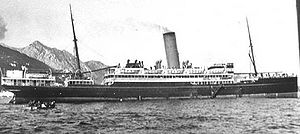SS Zealandia (1910)
 Zealandia off Port Davey, Tasmania in 1933. (Photograph by Henry Allport.) | |
| Career (Australia) | |
|---|---|
| Name: | SS Zealandia |
| Owner: | Huddart Parker |
| In service: | 1910 |
| Fate: | Sunk in air raids on Darwin, February 19, 1942 |
| General characteristics | |
| Tonnage: | 6,683 ton multi-decked single-funnelled |
| Propulsion: | single-funnel |
| Capacity: | 800 troops and 1,800 tons of supplies (typical, as troopship) |
| Crew: | 144 |
SS Zealandia, nicknamed Z (or "Zed") was a historically significant Australian cargo and passenger ship. It served as a troopship in both World War I and World War II. Zealandia transported the ill-fated Australian 8th Division. Its crew were the last Allied personnel to see HMAS Sydney, which was lost with all hands in 1941. Zealandia was sunk in the air raids on Darwin of February 19, 1942.
A 6,683 ton multi-decked single-funnelled vessel, Zealandia was built at Clydebank, Scotland and entered service in 1910. It was owned by the Melbourne-based Huddart Parker line. During 1910-13, it was chartered by the Union Steam Ship Company of New Zealand (Union NZ), mainly for use on the trans-Tasman route, but also undertaking voyages to ports as distant as Fremantle and Vancouver. Huddart Parker then used Zealandia on the Melbourne-Fremantle route.
World War I
In May 1918, the Zealandia was requisitioned as an Allied troopship and it was among the ships used to transport the American Expeditionary Force from the east coast of the U.S. to France. Following the Armistice, it was used a troopship on the Liverpool-Sydney route. In 1919, it resumed its commercial role with Huddart Parker.
World War II
On June 29, 1940, Zealandia embarked part of the 8th Division, the 2/21st Battalion, later known as Gull Force, at Sydney and transported it and other units to Darwin.
Zealandia transported another part of the 8th Division, Lark Force (otherwise known as the 2/22nd Battalion), to Rabaul, leaving Sydney on April 19, 1941. Following that voyage, Zealandia went to Noumea, New Caledonia and transported Free French troops to Sydney.
In mid-1941, Zealandia transported the main body of the 8th Division, their stores and equipment to Singapore (where the main body of the 8th was surrendered to Japanese forces in February 1942).
Following several other war-related voyages, in November 1941, Zealandia visited several Australian ports, on route to Singapore. A labour dispute involving some crew members caused it and HMAS Sydney to be delayed in leaving Fremantle, from where Zealandia was escorted to Sunda Strait by Sydney. As it happened, the crew of Zealandia were the last Allied personnel known to have seen the Sydney, which was sunk and lost with all hands in an action on November 19, by the German raider Kormoran.
Zealandia also took another 8th Division detachment, Sparrow Force, to Timor in November 1941, and then transported evacuees from Darwin to southern Australia.
In Sydney, the ship was fitted with material to protect its oil tanks in the event of attack. On January 23, Zealandia left Sydney, transporting an anti-tank company and its equipment to Darwin, where it arrived on February 6.
Sinking
During the air raids of February 19, a number of bombs fell close to Zealandia, before one fell through a hatch and exploded in a hold, causing a serious fire. Japanese planes also attacked Zealandia with their cannons and machine guns. Ammunition in one hold started to explode and the ship's fire pumps were disabled by another bomb. The order was given to abandon ship.
Zealandia went to the bottom of the harbour, with only its masts clear of the water. Two crew members died from wounds sustained in the attack. The remaining 142 crew members survived.
The ship was salvaged in 1960. What remains of Zealandia lies in Darwin Harbour at position 12°29.00′S 130°51.05′E / 12.483°S 130.85083°ECoordinates: 12°29.00′S 130°51.05′E / 12.483°S 130.85083°E at a depth of 19 metres (62 ft),[1][2] and is a dive site
References
- ↑ "World War II Shipwrecks". Northern Territory Government, Australia. http://www.nt.gov.au/nreta/heritage/ntregister/declared/display.html?wwships. Retrieved 10 March 2009.
- ↑ "WWII Wrecks". Darwin Dive Centre. http://www.darwindivecentre.com.au/wwii%20wrecks.html. Retrieved 10 March 2009.
